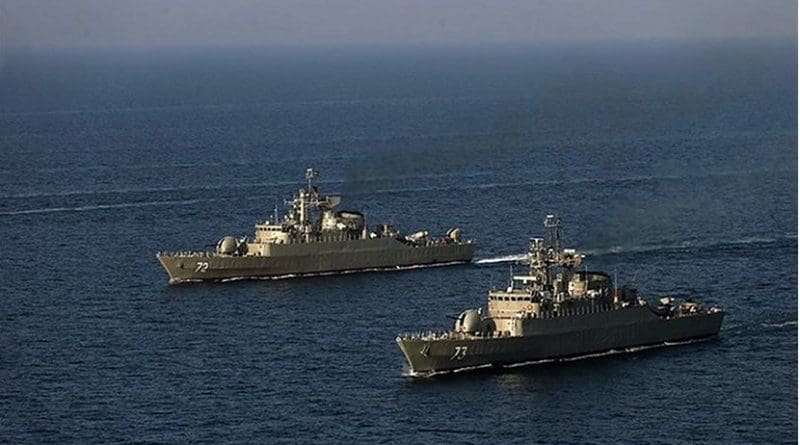Iran-US Naval Peril – OpEd
After the end of cold war and the disintegration of Soviet Union, US naval doctrine has gone through a remarkable transformation. Their center of attention transferred to the regional challenges and prospects. The coastal region continues to be defined unclearly as ‘areas adjacent to the oceans and seas within direct control of, and vulnerable to, the striking power of sea-based forces,’ even though it is understood to enlarge more than a thousand miles inland. This strategic perception has been more extended to cover the employment of naval designed for military operations abroad.
The first US ‘Navy Operational Concept’ established in March 1997 which clearly emphasized the significance and requirement of onward presence. It categorically declared that the basic purpose of forward deployed naval forces are to project US power from the sea and control events in the littoral regions of the world. It is an evident of establishment of an independent flotilla for the Indian Ocean, with the location of naval resources in the Western Indian Ocean (Persian Gulf) and Diego Garcia in the central Indian Ocean.
The nuclear stand off between US and Iran has created tension between both states. The current sanctions on Iran and the advancement of US warships to the Gulf part, in the same way, Iran has threatened to block the Strait of Hormuz (vital shipping route for oil exports from the Gulf) has started new debate. Both states are trying to coin their options to demoralize each other. Revolutionary Guard Deputy Commander Hossein Salami has stated that “US warships and military forces have been in the Persian Gulf and the Middle East region for many years and their decision in relation to the dispatch of a new warship is not a new issue and it should be interpreted as part of their permanent presence.”
Iran has long been aware of the geo-strategic significance of its proximity to the Strait of Hormuz. The threat of blockade the strait or targeting tankers with anti-ship missiles is a central part of Iran’s defensive strategy. By holding the strait at risk, Tehran expands the consequences of any military action against it to include playing havoc with global oil prices. The Iran’s blockade of Strait of Hormuz would close the millions of barrels a day of oil on which the world depends. The only threat has raised oil prices above 110$ a barrel.
The US upholds significant naval and military assets in strategic location of Persian Gulf and the costal states of Arabian Sea like, Qatar, Bahrain, Saudi Arabia, Kuwait and UAE. The main purpose of presence in the region is to get access on natural resources, trade and the security connections.
Bahrain: Since 1949, the Bahrain is like a second home port for US. Its air bases are also in use of American fighter jets. During the war against Iraq and Afghanistan the Naval and air basis of Bahrain were used. The government of Bahrain and US has signed many bilateral security agreements which are alarming caution for our region.
Oman: Oman is one of the key partners of US in Persian Gulf who has signed deal with US military supplies and equipment on its land and has many bilateral agreements. US military have the access on the three main bases (Masirah Air Base, the Thumrait Naval Air Base for anti-submarine patrol planes, and the Seeb International Airport of Oman) are used for US military equipment. The strategic position of Oman has given the edge to US to monitor Iran and South Asian region.
Qatar: The government of Qatar and US signed an agreement in 1991, which allowed US forces to install military equipments on her territory. Currently, Camp As-Sayliyah served as CENTCOM’s forward headquarters and command center. On the other hand, al-Udeid Air Base serves as the headquarters for CENTAF, CENTCOM’s air component. US has experienced Qatar for more then two decades, if in the case of US confrontation with Iran the basis of Qatar can create problem for us.
Saudi Arabia: The US and Saudi Arabian enjoys the bilateral military relationship. US have the main Air Force control center for air operations in Saudi. The Riyadh Air Base is also available for US military use. It is fact that Saudi Arabia was very much involved in US military activities and provided its basis, but with the passage of time being a holy state of the Muslims, it left much of its activities rather fully involved in the implementation of US policies. Saudi hasn’t much imperative influence on Iran. In the case of US and Iran confrontation Saudi Arabia being a Muslim nation, will be in great test.
United Arab Emirates: The US and UAE has signed a defence cooperation agreement in 1994. Since than the UAE carried on an extensive port visit programme for US navy ships at Jebel Ali and Abu Dhabi. It is also hosts the little amount of propositioned US navy equipments. Though the UAE is not much involved in international politics but likewise Saudi Arabia, the US-Iran hostile relation will also be the test for UAE.
No doubt that Iran navy has not such capability to defeat US naval forces but if it attached, it has a broad range of military options for lashing out at energy exports in the strait, and this is not a new development. Since the founding days of the Islamic republic, Iran has been exercising military force in the Persian Gulf, starting with attacks against Iraqi tankers during the Iran-Iraq War in 1980s. But in all this time, Iran has never exercised the full measure of its capability to close the Strait of Hormuz to maritime commerce; if it does, the situation will be worsening.

